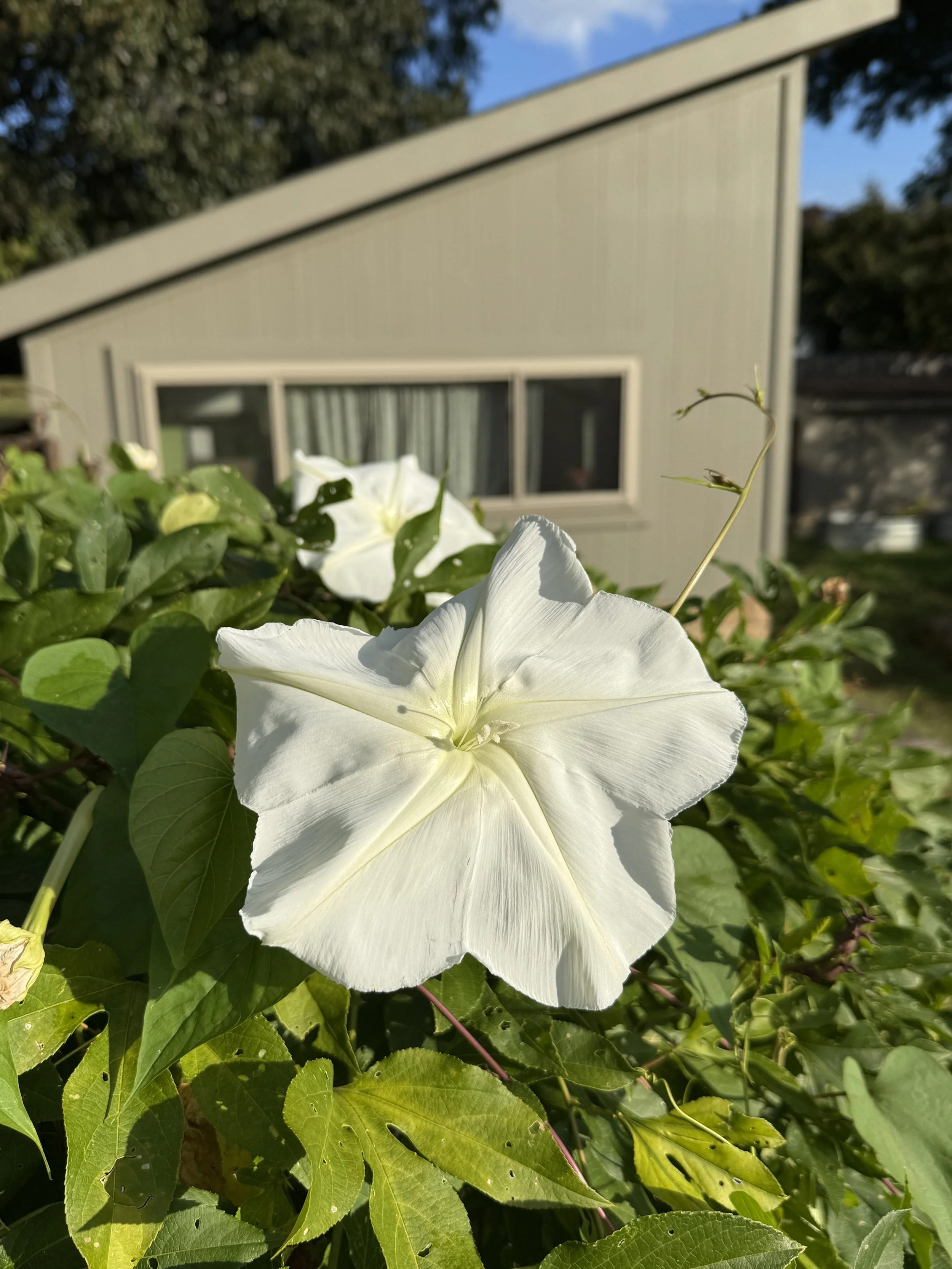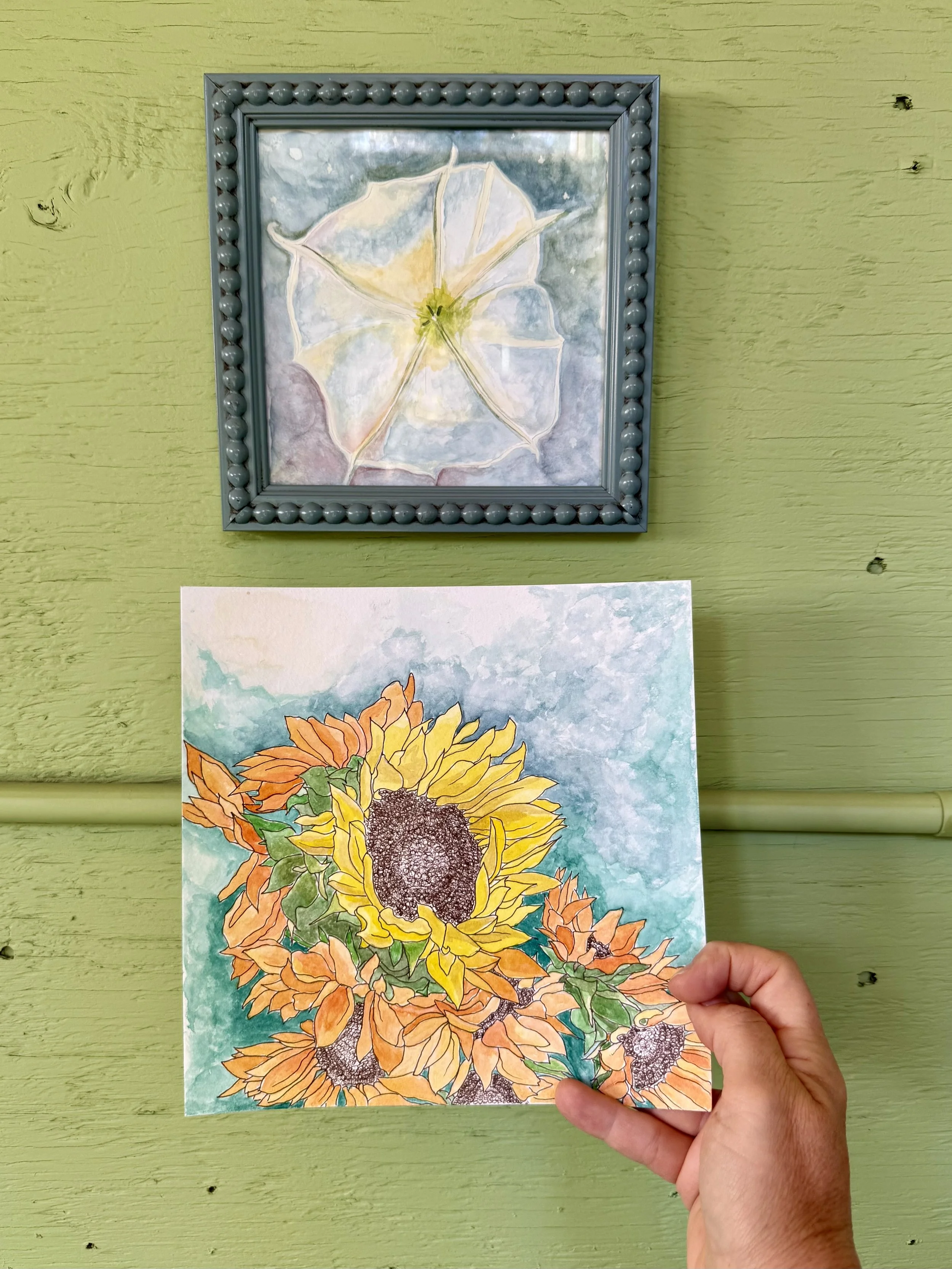Perennial Joy: On Karma, Moonflowers, Handwriting, and Digging a New Garden
Last week, I started a workshop on karma yoga with no expectations around it, but from the first session, I am pulled in. It’s part of my 300-hour yoga teacher training through Asheville Yoga Center, something I started without planning to earlier this year, and I’m so glad I did. It has helped guide me onto new paths at a time when I felt stuck at a standstill, immobilized by burnout from a few previous years of intense productivity and creativity coupled with some disappointment, especially career-wise.
Rather than shifting to find the next mile marker on the career climb, I’ve taken the time to explore and rediscover myself, my true inspiration and guideposts, and what I really value in life. The journey is as much about what I want and need as about what I don’t want or need, a process of pruning away so the whole can flourish. (And I am always up for a garden metaphor for life.)
Moonflowers (Ipomoea alba) growing on a trellis alongside passionflower vine in my garden.
Karma isn’t punishment – it’s about recognizing that actions and thoughts have effects. Simple. And recognizing that action and effects ripple into our daily lives. Some actions loom large, but it’s the small actions and thoughts, compounded over time, that can be the hardest to see and to change. They create samskara, the Sanskrit word for past impressions that can become a part of our personality, now known as neuropathways in neurology. I connect with the description of them as riverbeds where actions and thoughts flow; they become deeper and deeper so that thoughts and actions may become reflexive, mechanical.
Karma yoga is the work of shifting that flow, those reflexive thoughts and actions, toward the goal of intentional living, and like most valuable practices, it’s sometimes difficult and it takes a lifetime. In the first class, our teacher Suzanne Martin talked about the idea of “perennial joy” and that speaks to me, both as a nature metaphor and as a concept of lasting, evolving, growing joy rather than fleeting moments or spikes of joy.
Perennials provide joy year after year but they have seasons, ups and downs; they are not static. Even when they fade, I can know that they’ll return, and they’re never really gone at the roots, always under the surface. It can be that way with our joys, too, like creativity and focus that is there in some days or years and hibernating in others. Annuals, on the other hand, are bright and colorful but only for one season, quickly needing to be replaced. They’re beautiful but unsustainable.
I’ve come to feel, know, and embody the values of perennial joy. It may not be everyone’s way, but it is mine. Perennial joys like growing food and flowers, practicing meditation and movement in yoga, cooking and preserving vegetables and herbs, painting and drawing, and making with my hands – these sustain me.
In a practice of shifting neuropathways, I wrote this post out first by hand, something I’ve also been rediscovering this year through a journaling practice. Thinking back to when I started my first job out of college 25 years ago, I was still in the habit of writing everything by hand first before typing it out. It sounds anachronistic, but the neuropathway was brain-to-hand-to-paper; I didn’t have the pathways yet for brain to keyboard. Over those years, the riverbed has been carved by the need to write more quickly into the computer, and in that time, I’ve lost the feeling of writing with a pen, leaving thoughts on paper, shaping the letters with my wrist, but I am regaining some of that with journaling, and it feels good to once again connect brain-to-hand-to-paper intimately.
Karma is also described as weeding the garden, something I’ve been overwhelmed with the past year or two. My garden and gardening approach sparked the subject of my book The Creative Vegetable Gardener, but my life has evolved and now I’m needing to evolve that too. I’ve felt some shame in finding that some of the ideas and techniques I wrote about no longer work for me, and then even though I’ve championed letting go of perfection, enjoying the process, and accepting failures, I often fall short on all those things. But I am trying. I’ve realized about myself that even though I want freedom and creativity and flow, for me, these don’t thrive in chaos and without order, structure, and routine. I thrive within boundaries. Like most things, for me it’s about balance, the middle path. And right now, my garden is all weeds, no middle ground. It’s time for a change.
One thing in my garden that is bringing joy is the moonflowers. I seeded them after reading Night Magic: Adventures Among Glowworms, Moon Gardens, and Other Marvels of the Dark by Leigh Ann Henion, the best nature writing book I’ve read in a long time. Moonflowers also came up for me in somatic therapy, completely unprompted. They’re a symbol for feminine wisdom that comes with age. And I feel that, here in my mid-40s – I’m at a time of recognizing my own wisdom from experience and study and reflection. In my garden, for a few weeks, there have been both sunflowers and moonflowers blooming, and that feels like the ultimate emblem of this time in flower form. Sunflowers are bright, warm, happy, annual joy, and moonflowers are cool, white, alluring, perennial joy. Moonflowers can symbolize joy through the midst of darkness. I feel them both now and having them both in bloom is truly a blessing. I see why Georgia Okeefe became obsessed with painting these flowers.
Two watercolor paintings from this summer, one of moonflower and one of sunflowers. I’ve been playing with a looser style of drawing and painting, though my inclination is for detail.
Here are some more things feeding my perennial joy lately:
I met Maeve Hendrix through an Asheville Yoga Center workshop on Slow Flow + Restorative Yoga back in the spring. This is what led me into the 300-hour program. I’ve also been soaking up anything Maeve offers, including her podcast Your Body Knows and somatic coaching. I’d never heard of eco-somatics before her, but the process of connecting mind, body, and earth fits me perfectly. I especially love her episode on Boundaries in Nature.
I’ve seen Molly Reeder’s lovely, detailed watercolors of food and flowers before, but I went deeper into her offerings after signing up for a watercolor class with her at Shakerag Workshops for next year. When I got the 2026 schedule for Shakerag in my email and spotted her class, I felt a real, embodied sense that I needed to sign up. And so I did. It’s months away, but in the meantime, I’ve been digging into her Substack called Waxing and Weaving. A note in one of her posts led me to the next joy.
On the drive to and from Nashville last week to hang out with my nephews while my sister was in Japan, I listed to several episodes of The Nature Of podcast from Atmos magazine. This interview with Maggie Rogers feels parallel to a lot of what I’ve been thinking and experiencing lately, and this interview with Esther Perel about loneliness and community is at time heart-wrenching and hopeful.
A few days ago, I received in the mail The Kai Cookbook: A Love Letter to the West of Ireland by Jess Murphy, and I’ve already made three or four recipes out of it. I visited West Ireland a few years ago, and I felt deeply connected there. I didn’t eat at Kai, in Galway, then, but I promise to when I go back, because I know I will be back. The pickled nectarines are a gift that keeps on giving – I made them as a side to Lúnasa Larb for dinner, chopped them into oatmeal for breakfast, and I plan on using the brine, which tastes like a shrub, in a mocktail tonight. I also love that this cookbook is organized by the Celtic seasons, something I want to explore more in my own consideration of the cycles of the year in nature.
Finally, but most importantly, my sister Bonnie Smith Whitehouse has a new book coming out soon, all about how creative practices can save us. My sister and I have so many similar interests and paths, but we approach things in different ways. Having just spent quality time with my nephews, her boys, I see the same parallel but unique paths in them. I’ve had the joy of reading an early draft of her book and know her readers will love it, as I do. It’s a beautiful call to the perennial joy of creativity for its own sake.

